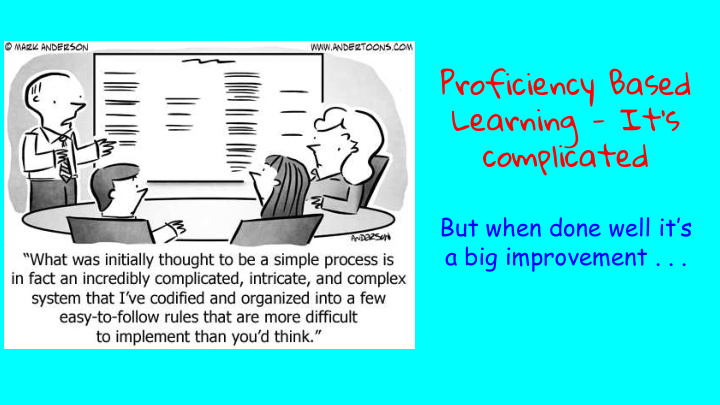



Proficiency Based Learning - It’s complicated But when done well it’s a big improvement . . .
Two goals for my two hour presentation: #1 - Reinforcing that the expectations in ACT 77 are good for students and teachers #2 - Reminding all that bringing about these expectations is going to be very challenging
Newsflash: SBG Does Not Improve Student Learning: CVU Learns Blog Post by Emily Rinkema Standards- based grading isn’t the answer. It will not boost our students’ achievement. It will not increase our students’ engagement. It will not raise the rigor of our classrooms. But standards-based learning (SBL) will do all of these things. SBG without SBL won't work. These terms and initials are often used interchangeably, but the distinction is critical. We would like to argue here that schools and teachers must understand and embrace changes in learning before attempting changes in grading . We must transform our instructional practices if we want our grading practices to reflect learning. LINK To Blog
Emily sites five ways that her instructional practices have changed ● Targets, not content, drive instruction: ● Teachers plan in response to data from formative assessments: ● Students spend the majority of every class practicing and playing and thinking and trying: ● Groupings, furniture setup, and classroom structures change constantly based on the learning needs: ● Students track their own learning and take control over the paths they take to that learning: While these appear to be common sense practices implementation is much more complicated than “traditional” teaching pedagogy.
“The person doing the work does the learning.”
When you search “modern classroom” in Google images - Here are the first five results.
Why building practices around SBL/PBL is an improvement over traditional (and easier) practices? Using an example that is close to home (literally): The he Clas Class: German IV/V The summative assessment: Short answer questions around novel students read in class. The dilemma: How do you assess The discussion: The goal of German students who answer the question IV/V is to become “intermediate” correctly, but use basic sentence language users (ACTFL standards). structures? Or students who don’t Using basic sentence structure is get the answer fully correct, but considered at the “novice” level. use more complex sentence Students with a higher “level of structures? language control” are more proficient. (Two grades)
How the students get to proficient: Quizzes are “stepping stones”: Impromptu Situations: You are at your host family’s house and they only have Formative assessments that provides the teacher and student with one bathroom. Have a conversation with information about understanding. your partner about how you communicate about the sharing of this bathroom. Encourage students to challenge Clear Standards: ACTFL themselves: Encourage the use of more provides clear guidance about complex language structures - more reward recognizing Novice or for trying versus punishment for getting it Intermediate language users - wrong. also Advanced, but this is usually at the college level. Practice: Many opportunities to practice during class “Sympathetic Listener”
What was language teaching like 20 years ago? (Or in some cases today . . .) Memorized dialogues Vocabulary Quizzes Passage Translations Textbook exercises - Fill in the blank, grammar worksheets The thinking my wife is doing about instruction and assessment is so much deeper much more focused on the needs of her students. ● Will they be speaking German 10 years from now? Probably not. ● Are they learning broader skills that will help them no matter what they do? Yes.
Were these five strategies employed in a “typical” classroom during your educational experience? ● Targets, not content, drive instruction: ● Teachers plan in response to data from formative assessments: ● Students spend the majority of every class practicing and playing and thinking and trying: ● Groupings, furniture setup, and classroom structures change constantly based on the learning needs: ● Students track their own learning and take control over the paths they take to that learning: These are not “transactional” changes, they are “transformative” changes. Much higher degree of difficulty.
So what needs to be done . . . (in my opinion) “Increased flexibility for students requires increased teacher flexibility.” MLR Keep moving forward, support the good work that is happening across the state. Understand that there are going to be growing pains. All transformational work has struggles.
Recommend
More recommend